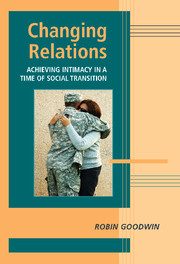30 results
Disability and post-traumatic stress symptoms in the Ukrainian General Population during the 2022 Russian Invasion
- Part of
-
- Journal:
- Epidemiology and Psychiatric Sciences / Volume 32 / 2023
- Published online by Cambridge University Press:
- 18 April 2023, e21
-
- Article
-
- You have access
- Open access
- HTML
- Export citation
Relationship between adjustment disorder symptoms and probable diagnosis before and after second lockdown in Israel: longitudinal symptom network analysis
-
- Journal:
- BJPsych Open / Volume 8 / Issue 6 / November 2022
- Published online by Cambridge University Press:
- 18 October 2022, e186
-
- Article
-
- You have access
- Open access
- HTML
- Export citation
COVID-19 post-vaccination depression in older Israeli adults: the role of negative world assumptions
-
- Journal:
- Global Mental Health / Volume 9 / 2022
- Published online by Cambridge University Press:
- 31 January 2022, pp. 45-48
-
- Article
-
- You have access
- Open access
- HTML
- Export citation
A storm in a teacup: older adults’ low prevalence of COVID-19 vaccine side-effects and their link with vaccination anxiety
-
- Journal:
- International Psychogeriatrics / Volume 33 / Issue 12 / December 2021
- Published online by Cambridge University Press:
- 07 September 2021, pp. 1335-1337
-
- Article
-
- You have access
- HTML
- Export citation
Authors' reply
-
- Journal:
- The British Journal of Psychiatry / Volume 218 / Issue 3 / March 2021
- Published online by Cambridge University Press:
- 24 February 2021, pp. 172-173
- Print publication:
- March 2021
-
- Article
-
- You have access
- HTML
- Export citation
Investigating the relationship between COVID-19-related and distress and ICD-11 adjustment disorder: two cross-sectional studies
-
- Journal:
- BJPsych Open / Volume 7 / Issue 1 / January 2021
- Published online by Cambridge University Press:
- 28 December 2020, e21
-
- Article
-
- You have access
- Open access
- HTML
- Export citation
Psychological distress after the Great East Japan Earthquake: two multilevel 6-year prospective analyses — CORRIGENDUM
-
- Journal:
- The British Journal of Psychiatry / Volume 217 / Issue 3 / September 2020
- Published online by Cambridge University Press:
- 26 May 2020, p. 525
- Print publication:
- September 2020
-
- Article
-
- You have access
- HTML
- Export citation
Psychological distress after the Great East Japan Earthquake: two multilevel 6-year prospective analyses
- Part of
-
- Journal:
- The British Journal of Psychiatry / Volume 216 / Issue 3 / March 2020
- Published online by Cambridge University Press:
- 02 December 2019, pp. 144-150
- Print publication:
- March 2020
-
- Article
-
- You have access
- HTML
- Export citation
Psychological distress among tsunami refugees from the Great East Japan earthquake
-
- Journal:
- BJPsych Open / Volume 1 / Issue 1 / June 2015
- Published online by Cambridge University Press:
- 02 January 2018, pp. 92-97
-
- Article
-
- You have access
- Open access
- HTML
- Export citation
1 - The influence of globalization and technological development on intimate relationships
- from Part I - Global and societal influences on romantic relationships
-
-
- Book:
- Social Influence on Close Relationships
- Published online:
- 05 October 2014
- Print publication:
- 09 October 2014, pp 11-32
-
- Chapter
- Export citation
Contributors
-
-
- Book:
- Social Influence on Close Relationships
- Published online:
- 05 October 2014
- Print publication:
- 09 October 2014, pp viii-x
-
- Chapter
- Export citation
OTHER BOOKS IN THE SERIES
-
- Book:
- Changing Relations
- Published online:
- 21 October 2009
- Print publication:
- 08 December 2008, pp 222-222
-
- Chapter
- Export citation
Acknowledgements
-
- Book:
- Changing Relations
- Published online:
- 21 October 2009
- Print publication:
- 08 December 2008, pp xxi-xxii
-
- Chapter
- Export citation
Contents
-
- Book:
- Changing Relations
- Published online:
- 21 October 2009
- Print publication:
- 08 December 2008, pp ix-xii
-
- Chapter
- Export citation
6 - Marriage and the Family
-
- Book:
- Changing Relations
- Published online:
- 21 October 2009
- Print publication:
- 08 December 2008, pp 114-175
-
- Chapter
- Export citation
3 - More Beautiful than a Monkey: The Achievement of Intimacy
-
- Book:
- Changing Relations
- Published online:
- 21 October 2009
- Print publication:
- 08 December 2008, pp 43-62
-
- Chapter
- Export citation

Changing Relations
- Achieving Intimacy in a Time of Social Transition
-
- Published online:
- 21 October 2009
- Print publication:
- 08 December 2008
References
-
- Book:
- Changing Relations
- Published online:
- 21 October 2009
- Print publication:
- 08 December 2008, pp 187-216
-
- Chapter
- Export citation
Frontmatter
-
- Book:
- Changing Relations
- Published online:
- 21 October 2009
- Print publication:
- 08 December 2008, pp i-viii
-
- Chapter
- Export citation
4 - Friends and Social Networks
-
- Book:
- Changing Relations
- Published online:
- 21 October 2009
- Print publication:
- 08 December 2008, pp 63-94
-
- Chapter
- Export citation

